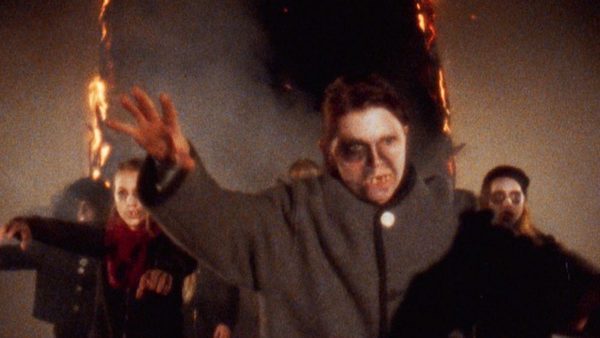Fantastic Fest Review: DIE KINDER DER TOTEN Is An Experimental Mess
Directors Kelly Copper and Pavol Liška take on Elfriede Jelinek’s epic and “unfilmable” novel, Die Kinder Der Toten, in their debut feature of the same name. This quasi-silent political satire with zombies is a peculiar exercise in experimentation, but it’s one that never fully stacks up to anything substantial, making it a collection of semi-intriguing images and not much more.
After dying in an accident, Karin (Andrea Maier) returns as one of the undead. In a cinema owned by a Nazi widow where the past is mourned, she brings the dead back to life.
Shot entirely without dialogue, Die Kinder Der Toten relies largely on its brass band score and heightened sound design to give this otherwise (un)dead film a much needed pulse. Its gritty and raw Super 8 home movie aesthetic creates a haunting atmosphere full of wet, dry, and fog-torn Austrian landscapes that help to draw a viewer in; however, its appeal quickly wears thin. Simply put, there’s not enough to keep someone engaged for 90 minutes. And that’s predominantly Die Kinder Der Toten’s problem: it’s not as interesting, enjoyable, clever, or cool as the filmmakers seem to think it is.
There’s not much sense of urgency to it, and the film seems content to meander and wallow in its own obscurity. There’s never really a point in which it steps on the gas, and it feels infinitely longer than its standard runtime given the silent-era format and lack of a coherent story. While a lot of things occur, nothing really ever happens in any easily digestible or meaningful sense. Instead of tightening the narrative and the perceived symbolism of its images, Die Kinder Der Toten opts to hurl all of its scattered ideas at the viewer hoping it’ll stick, and its success rate — at least for us — was very very low. A handful of striking images isn’t going to hold the attention of many viewers, especially when their implicit meaning is intentionally obtuse.
There’s also very little artistry to the film’s cinematic quality, particularly Copper and Liška’s direction. Everything is competently amateurish, full of loose handheld with a rudimentary understanding of composition. The film’s style seems indebted to Romero, Warhol, Buñuel, and the French New Wave, all of which are visibly worn on its sleeve; however, there’s not one single aspect about Die Kinder Der Toten that could hold a candle to the boldness or ingenuity of the aforementioned filmmakers, which make Copper and Liška’s “vision” feel more like an imitation than anything. They present a lot of symbolic images — there are Syrian poets juxtaposed against Styrian dishes (for no real reason), Fascist nostalgia, ghostly doppelgängers, zombies, and a cine-seance — but they never resonate much deeper than surface-level, causing more confusion than satisfaction (and maybe that’s partially because we’re not Austrian).
To add insult to injury, it appears to have been clumsily edited together with a weedwacker, which may’ve been intentional (but intention doesn’t mark it successful). It’s full of short, choppy cuts that quickly bounce between characters or their expressions, leading to some dizzying and nauseating moments. The editing rarely gives the surreal visuals much time to breathe or allow the viewer to attempt to make sense of it all; it’s just one half-baked trainwreck after another. Not to mention that part of the film’s appeal is that it has zombies, but they only enter the film in its final 30 minutes, and they ultimately lead to more disappointment. At least the film has a sense of humor to it, which is mostly presented in the description and dialogue cards that are often peppered with funny phrases and plays on words. It’s enough for a few chuckles, but much like the rest of the film, it’s not enough to wholly satiate; more miss than hit.
At the end of the day, Die Kinder Der Toten is a sometimes amusing, frequently confusing, and thoroughly boring mess of a film. It really only provides a smattering of interesting images and a cool atmospheric soundtrack, which really is not worth the headache. Wethink it’s safe to say this experiment is a failure, but maybe there’s an audience out there for this — it just ain’t us.
Recommendation: Unless you’re a collector of bizarre images and odd cinematic experiences, don’t waste your time with this one.
Rating: 1 “zomb” outta 5.
What do you think? Share your thoughts and feelings in the comments section below, and as always, remember to viddy well!


